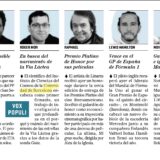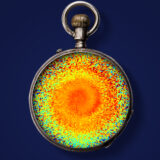Roger Mor: En busca del nacimiento de la Vía Láctea (El Mundo, 13/05/2019)
ROGER MOR En busca del nacimiento de la Vía Láctea (El Mundo) El científico del Instituto de Ciencias del Cosmos de la Universidad de Barcelona encabeza como primer firmante, un trabajo de investigación que profundiza en el porqué y cuándo del nacimiento de las estrellas de la Vía Láctea gracias a los datos de la sonda Gaia.
read moreUn inesperado ‘baby boom’ de estrellas en la Vía Láctea (El Mundo, 13 Mayo 2019)
Un inesperado ‘baby boom’ de estrellas en la Vía Láctea Científicos de Barcelona descubren que buena parte de los astros de la galaxia nacieron en una época en la que quedaba poco gas. El choque con otra galaxia pudo haber reactivado su formación Date: 13 Mayo 2017 Media: El Mundo Link to the new: https://www.elmundo.es/ciencia-y-salud/ciencia/2019/05/13/5cd7140bfc6c83be238b477e.html La historia de una estrella es una historia convulsa. Como la de las galaxias en las que viven. Y gracias a una nave espacial que está estudiando más de mil millones de astros los científicos están...
read moreGaia detects a shake in the Milky Way
Image: The spiral shape of fig 1c of our article appears inside an old watch symbolising the fact that these data has allowed us to date back the perturbation that shook the Milky Way disk. This figure shows how from the new obtained Gaia data we can know more about the past of the Galaxy. Credit: Edmon de Haro/iStock. Researchers of the UB and the University of Groningen lead one of the first big discoveries from the Gaia Mission, published in Nature A team led by researchers from the Institute of Cosmos Sciences of the University of Barcelona (ICCUB, UB-IEEC) and the...
read moreGaia’s snapshot of another galaxy (ESA, 20 April 2017)
Gaia’s snapshot of another galaxy Link: http://sci.esa.int/gaia/59023-gaia-s-snapshot-of-another-galaxy/ While compiling an unprecedented census of one billion stars in our Galaxy, ESA’s Gaia mission is also surveying stars beyond our Milky Way. A new image of M33, also known as the Triangulum galaxy, shows tens of thousands of stars detected by Gaia, including a small stellar census in its star-forming region NGC 604. This is a striking example of the mission’s potential to detect and characterise stars in nearby galaxies. Gaia’s view of the M33 galaxy. Credit:...
read moreLa misión Gaia y la historia de nuestra galaxia
Title: La misión Gaia y la historia de nuestra galaxia Authors: Carme Jordi, Eduard Masana Journal: Investigación y Ciencia, núm 487, abril 2017 Link: http://www.investigacionyciencia.es/revistas/investigacion-y-ciencia/numero/487/la-misin-gaia-y-la-historia-de-nuestra-galaxia-15116 La misión Gaia y la historia de nuestra galaxia La mayor cámara jamás enviada al espacio determinará con una precisión extraordinaria las posiciones, distancias, movimientos y propiedades de más de mil millones de estrellas de la Vía Láctea. ¿Por qué es tan importante este proyecto? Jordi, Carme Masana,...
read moreGaia discovers its first supernova
Date: 12 September 2014 Original link: ESA webpage While scanning the sky to measure the positions and movements of stars in our Galaxy, Gaia has discovered its first stellar explosion in another galaxy far, far away. This powerful event, now named Gaia14aaa, took place in a distant galaxy some 500 million light-years away, and was revealed via a sudden rise in the galaxy’s brightness between two Gaia observations separated by one month. Gaia, which began its scientific work on 25 July, repeatedly scans the entire sky, so that each of the roughly one billion stars in the...
read more







